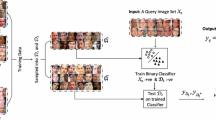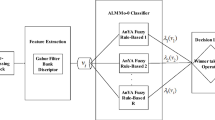Abstract
This paper addresses the applicability of multi-class Logical Analysis of Data (LAD) as a face recognition technique (FRT). This new classification technique has already been applied in the field of biomedical and mechanical engineering as a diagnostic technique; however, it has never been used in the face recognition literature. We explore how Eigenfaces and Fisherfaces merged to multi-class LAD can be leveraged as a proposed FRT, and how it might be useful compared to other approaches. The aim is to build a single multi-class LAD decision model that recognizes images of the face of different persons. We show that our proposed FRT can effectively deal with multiple changes in the pose and facial expression, which constitute critical challenges in the literature. Comparisons are made both from analytical and practical point of views. The proposed model improves the classification of Eigenfaces and Fisherfaces with minimum error rate.
Similar content being viewed by others
References
W. Zhao, R. Chellappa, P. J. Phillips, and A. Rosenfeld, “Face recognition: a literature survey,” Acm Comput. Surv. 35, 399–458 (2003).
I. H. Witten, E. Frank, and M. A. Hall, Data Mining: Practical Machine Learning Tools and Techniques (Morgan Kaufmann, 2011).
P. N. Belhumeur, J. P. Hespanha, and D. J. Kriegman, “Eigenfaces vs. fisherfaces: recognition using class specific linear projection,” IEEE Trans. Pattern Anal. Mach. Intellig. 19, 711–720 (1997).
A. Tolba, A. El-Baz, and A. El-Harby, “Face recognition: a literature review,” Int. J. Signal Processing 2, 88–103 (2005).
A. Mokeev and V. Mokeev, “Pattern recognition by means of linear discriminant analysis and the principal components analysis,” Pattern Recogn. Image Anal. 25, 685–691 (2015).
K. Etemad and R. Chellappa, “Discriminant analysis for recognition of human face images,” J. Opt. Soc. Am. A 14, 1724–1733 (1997).
P. E. Hart and D. G. Stork, Pattern Classification (John Willey and Sons, 2001).
G. Shakhnarovich and B. Moghaddam, “Face recognition in subspaces,” in Handbook of Face Recognition, Ed. by S. Z. Li and A. K. Jain (Springer, London, 2011), pp. 19–49.
M. A. Turk and A. P. Pentland, “Face recognition using eigenfaces,” in Proc. IEEE Computer Society Conf. on Computer Vision and Pattern Recognition CVPR’91 (Lahaina, Maui, June 3–6, 1991), pp. 586–591.
G. Guo, S. Z. Li, and K. L. Chan, “Support vector machines for face recognition,” Image Vision Comput. 19, 631–638 (2001).
L. Ganesan, “Face recognition using neural networks,” Signal Processing: Int. J. 3, 153 (2009).
F. Kornilov, “Comparative analysis of algorithms for detecting structural changes in images,” Pattern Recogn. Image Anal. 25, 593–602 (2015).
Y. Adini, Y. Moses, and S. Ullman, “Face recognition: the problem of compensating for changes in illumination direction,” IEEE Trans. Pattern Anal. Mach. Intellig. 19, 721–732 (1997).
E. Boros, P. Hammer, and T. Ibaraki, “Logical analysis of data,” in Encyclopedia of Data Warehousing and Mining (Idea Group Publ., 2005), pp. 689–692.
Y. Crama, P. L. Hammer, and T. Ibaraki, “Causeeffect relationships and partially defined Boolean functions,” Ann. Operat. Res. 16, 299–325 (1988).
M. A. Mortada, S. Yacout, and A. Lakis, “Diagnosis of rotor bearings using logical analysis of data,” J. Quality Maintenance Eng. 17 (4), 371–397 (2011).
E. Bores, P. L. Hammer, T. Ibaraki, A. Kogan, E. Mayoraz, and I. Muchnik, “An implementation of logical analysis of data,” IEEE Trans. Knowledge Data Eng. 12, 292–306 (2000).
S. Y. D. Salamanca, “Condition based maintenance with logical analysis of data,” in Proc. 7th Congress Int. de genie industriel (Quebec, 2007).
M. A. Mortada, T. Carroll, S. Yacout, and A. Lakis, “Rogue components: their effect and control using logical analysis of data,” J. Intellig. Manuf. 23 (2), 1–14 (2009).
A. Ragab, M.-S. Ouali, S. Yacout, and H. Osman, “Remaining useful life prediction using prognostic methodology based on logical analysis of data and Kaplan–Meier estimation,” J. Intellig. Manuf. 27 (5), 943–958 (2014).
C. Ding and D. Tao, “A comprehensive survey on pose-invariant face recognition,” ACM Trans. Intellig. Syst. Technol. 7, 37 (2016).
B. Heisele, P. Ho, and T. Poggio, “Face recognition with support vector machines: global versus component-based approach,” in Proc. 8th IEEE Int. Conf. on Computer Vision ICCV 2001 (Vancouver, 2001), Vol. 2, pp. 688–694.
S. Xie, F. Shen, and X. Qiu, “Face recognition using support vector machines,” Comput. Eng. 35 (16), 186–188 (2003).
L. Wang, Support Vector Machines: Theory and Applications (Springer Verlag, 2005).
A. T. Sahlol, C. Y. Suen, M. R. Elbasyouni, and A. A. Sallam, “A proposed OCR algorithm for the recognition of handwritten Arabic characters,” J. Pattern Recogn. Intellig. Syst. 2 (1), 8–22 (2014).
C. M. Bishop, Neural Networks for Pattern Recognition (Oxford Univ. Press, 1995).
N. Jamil, S. Lqbal, and N. Iqbal, “Face recognition using neural networks,” in Proc. IEEE Int. Multi Topic Conf. Technology for the 21st Century INMIC 2001 (Lahore, 2001), pp. 277–281.
C. Liu and H. Wechsler, “A unified Bayesian framework for face recognition,” in Proc. Int. Conf. on Image Processing ICIP 98 (Chicago, 1998), Vol. 1, pp. 151–155.
B. Moghaddam, T. Jebara, and A. Pentland, “Bayesian face recognition,” Pattern Recogn. 33, 1771–1782 (2000).
M. J. Lyons, S. Akamatsu, M. Kamachi, J. Gyoba, and J. Budynek, The Japanese female facial expression (JAFFE) database (1998). http://www.kasrl.org/jaffe.html.
Face Database. Image Engineering Laboratory (University of Sheffield). http://www.sheffield.ac.uk/eee/research/iel/research/face.
H. Moon and P. J. Phillips, “Computational and performance aspects of PCA-based face-recognition algorithms,” Perception 30 (3), 303–322 (2001).
W. Zhao, R. Chellappa, and A. Krishnaswamy, “Discriminant analysis of principal components for face recognition,” in Proc. 3rd IEEE Int. Conf. on Automatic Face and Gesture Recognition (Nara, 1998), pp. 336–341.
A. Ragab, M.-S. Ouali, S. Yacout, and H. Osman, “Condition-based maintenance prognostics using logical analysis of data,” in Proc. IIE Annu. Conf. (Institute of Industrial Engineers-Publ., 2014), p. 378.
E. Mayoraz and M. Moreira, “On the decomposition of polychotomies into dichotomies,” in Proc. 14th Int. Conf. on machine Learning (Nashville, TN, 1997), pp. 219–226.
L. M. Moreira, The Use of Boolean Concepts in General Classification Contexts (Universidade do Minho, 2000).
M.-A. Mortada, S. Yacout, and A. Lakis, “Fault diagnosis in power transformers using multi-class logical analysis of data,” J. Intellig. Manuf. 25 (6), 1429–1439 (2014).
H. S. Ryoo and I. Y. Jang, “Milp approach to pattern generation in logical analysis of data,” Discrete Appl. Math. 157, 749–761 (2009).
S. Alexe, E. Blackstone, P. L. Hammer, H. Ishwaran, M. S. Lauer, and C. E. Pothier Snader, “Coronary risk prediction by logical analysis of data,” Ann. Operat. Res. 119, 15–42 (2003).
P. L. Hammer, A. Kogan, B. Simeone, and S. Szedmak, “Pareto-optimal patterns in logical analysis of data,” Discrete Appl. Math. 144, 79–102 (2004).
P. L. Hammer and T. O. Bonates, “Logical analysis of data–an overview: from combinatorial optimization to medical applications,” Ann. Operat. Res. 148, 203–225 (2006).
C. Guo and H. S. Ryoo, “Compact MILP models for optimal and Pareto-optimal LAD patterns,” Discrete Appl. Math. 160 (16), 2339–2348 (2012).
R. R. Bouckaert, E. Frank, M. A. Hall, G. Holmes, B. Pfahringer, P. Reutemann, and I. H. Witten, “WEKA–experiences with a Java open-source project,” J. Mach. Learn. Res. 11, 2533–2541 (2010).
S. Yacout, D. Salamanca, and M. A. Mortada, WO Patent WO/2012/009,804 (2012).
M. Berkelaar, K. Eikland, and P. Notebaert, lp solve: open source (mixed-integer) linear programming system, version 5.5 (2005). http://tech.groups.yahoo.com/group/lp_solve.
CPLEX optimizer–high-performance mathematical programming solver for linear programming, mixed integer programming, and quadratic programming. https://www-01.ibm.com/software/commerce/optimization/cplex-optimizer/index.html.
Author information
Authors and Affiliations
Corresponding author
Additional information
The article is published in the original.
Ahmed Ragab received a B.Sc. in Electronic Engineering and the M.Sc. in Control Engineering from Faculty of Electronic Engineering, Minuf, Egypt in 2003 and 2007, respectively. He received the PhD. degree in Industrial Engineering from École Polytechnique de Montreal, Canada in 2014. His research interests are: Machine Learning and Pattern Recognition, Condition-Based Maintenance, Fault Diagnosis and Prognosis, Discrete Event Systems, Control Systems, Petri Nets, Timed Automata, and Operations Research
Xavier de Carné de Carnavalet received in 2014 a Diplome d’Ingénieur (M.Sc.) from École Supérieure d’Informatique, Électronique et Automatique, Paris, France, and anM.A.Sc. in Information Systems Security from Concordia University, Montreal, QC, Canada. His research interests are: privacy, passwords and authentication, TLS, trusted computing, reverse-engineering, and machine learning applications to information systems security.
Soumaya Yacout is Professor of Industrial Engineering and Operations Research at École Polytechnique de Montréal in Canada since 1999. She received a D.Sc. in Operations Research in 1985, and a M.Sc. in Industrial Engineering in 1979. Her research interests include Condition- Based Maintenance and optimization of decision making for product quality. She is a senior member of the American Society for Quality (ASQ) and the Canadian Operations Research Society (CORS).
Mohamed-Salah Ouali is a Professor of Industrial Engineering at the École Polytechnique de Montréal. His research interests focus on reliability modeling, multiple failure modes diagnosis, and long-term fleet maintenance. He obtained his Doctorate degree from the Institut National Polytechnique de Grenoble, France, in 1996, and worked as assistant professor at Moncton University, New-Brunswich, from 1998 to 2000. He is a member of the Interuniversity Research Centre on Enterprise networks, Logistics and Transport (CIRRELT) and the Ordre des Ingenieurs du Québec, Canada.
Rights and permissions
About this article
Cite this article
Ragab, A., de Carné de Carnavalet, X., Yacout, S. et al. Face recognition using multi-class Logical Analysis of Data. Pattern Recognit. Image Anal. 27, 276–288 (2017). https://doi.org/10.1134/S1054661817020092
Received:
Published:
Issue Date:
DOI: https://doi.org/10.1134/S1054661817020092




